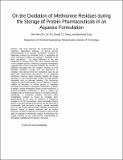| dc.contributor.author | Chu, Jhih-Wei | |
| dc.contributor.author | Yin, Jin | |
| dc.contributor.author | Wang, Daniel I.C. | |
| dc.contributor.author | Trout, Bernhardt L. | |
| dc.date.accessioned | 2003-12-16T14:08:38Z | |
| dc.date.available | 2003-12-16T14:08:38Z | |
| dc.date.issued | 2004-01 | |
| dc.identifier.uri | http://hdl.handle.net/1721.1/3940 | |
| dc.description.abstract | This study addresses the fundamentals of an important degradation pathway of storing protein pharmaceuticals in an aqueous formulation, oxidation of methionine residues by peroxides. First, a mechanism by which methionine residues are oxidized is identified via ab initio calculations. The major difference of this new mechanism to previous ones is the role of solvent molecules in the oxidation process. Previously proposed mechanisms suggested that solvent molecules facilitate the transfer of hydrogen associated with the oxidation reaction, but the estimated activation energies and pH dependence of oxidation rates derived from this mechanism rates do not agree with experimental observations. In our proposed mechanism, however, water molecules stabilize the charge separation in the transition-state complex through specific interaction such as hydrogen bonding. This mechanism satisfies all experimental studies on the oxidation of organic sulfides by peroxides. A correct picture of instability mechanism is essential in developing stabilization strategies to design a robust formulation. Based on this mechanism, a structure/instability relationship is built to explain the oxidation rates of methionine residues in a protein molecule. Specifically, a structural property, two-shell water coordination number, is found to correlate semi-quantitatively to the rates of oxidation of methionine residues in G-CSF (granulocyte colony-stimulating factor) and hPTH (human parathoid hormone). We also show that a traditionally used structural property, solvent accessible area, can not provide such accurate correlation and that the dynamic motion of protein molecules and an explicit treatment of solvent molecules are essential to describe the rates of oxidation of methionine residues. Furthermore, the insight provided by the molecule-level understanding in developing a stabilizing formulation is discussed. | en |
| dc.description.sponsorship | Singapore-MIT Alliance (SMA) | en |
| dc.format.extent | 12362 bytes | |
| dc.format.mimetype | application/pdf | |
| dc.language.iso | en_US | |
| dc.relation.ispartofseries | Molecular Engineering of Biological and Chemical Systems (MEBCS); | |
| dc.subject | oxidation of methionine residues | en |
| dc.subject | protein pharmaceuticals storage | en |
| dc.subject | two-shell water coordination number | en |
| dc.title | On the Oxidation of Methionine Residues during the Storage of Protein Pharmaceuticals in an Aqueous Formulation | en |
| dc.type | Article | en |
